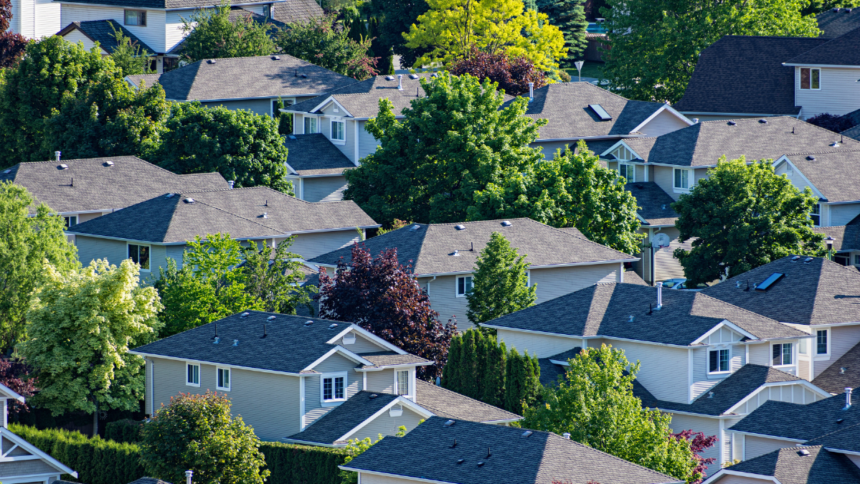Candidates across Montana’s political spectrum expect the state’s 2023 spike in residential property tax bills to be top of mind for many voters as they head to the polls this November. As such, Republican and Democratic factions are floating a variety of strategies for providing property tax relief to homeowners as candidates compete for support from frustrated voters this year.
Those proposals, some more detailed than others, would generally dial back taxes on residential property. They differ in whether to treat second homes and luxury properties differently from primary residences, as well as where they would dial taxes up to cover the cost of homeowner tax relief.
Apart from this year’s round of one-off $675 property tax rebates, one of two approved by the GOP-controlled Legislature and Republican Gov. Greg Gianforte last year, property tax reform will have to be negotiated by the 2025 Legislature when it meets next winter. So the specifics of any long-term relief for Montana homeowners will depend both on whether Democrats win additional leverage by clawing legislative seats back from the current GOP supermajority and the outcome of the race for governor between Gianforte and his Democratic challenger, Ryan Busse.
Montana Free Press estimated previously that the median residential property in Montana saw a 21% higher property tax bill in 2023 than it did in 2022, a dynamic stemming from several factors, including dramatic increases in residential property values, which pulled some of the tax burden previously carried by businesses and industrial properties onto homes. MTFP estimated that residential property owners across Montana paid $213 million more in property taxes in 2022 than they did in 2023.
THE STATUS QUO
Montana, one of five U.S. states without a sales tax, relies primarily on income and property taxes to fund state and local government programs. Income taxes collected by the Montana Department of Revenue fund the lion’s share of state government: health and social service programs, the state prison system and state-level support for K-12 schools and public universities. Property taxes, collected by county treasurers under the auspices of a tax code specified by the Legislature, generally fund local services such as law enforcement, fire departments, and the rest of the bill for K-12 schools. (One chunk of property tax bills, the so-called 95 mills, is transmitted to the state and redistributed to schools in an effort to equalize funding between richer and poorer districts.)
The math involved in translating local service budgets to individual tax bills can be quite complex — for schools in particular — but property owners generally pay in rough proportion to property values, with higher-value properties owing more taxes.
The state tax code does, however, specify conversion rates that translate each property’s appraised market value to its taxable value, the latter of which is used to calculate tax bills. That gives the Legislature a way to balance tax burden between different types of properties, assigning higher conversion rates to property classes lawmakers believe should pay more. For example, under the current code, most residential properties are converted at a rate of 1.35%, while most commercial properties are converted at a higher 1.89% rate. (Oil pipelines, in comparison, have a much higher 12% conversion rate.)
Dialing those conversion rates up or down can shift more or less tax burden onto different classes of property. But the reality facing any lawmaker looking to lighten the load on a specific type of taxpayer is that the weight of funding schools and police officers needs to be shouldered somewhere. As a result, property tax proposals that don’t introduce a new set of taxpayers to the equation (say, by roping in out-of-state tourists with a sales tax) or cut local spending (say, by laying off cops and teachers) will inevitably shift weight from some taxpayers to others — a dynamic lawmakers and analysts often liken to squeezing a balloon.
THE GOVERNOR’S TAX RELIEF TASK FORCE
A tax relief task force established by Gianforte earlier this year is currently in the final stages of preparing recommendations for potential property tax legislation. The group is suggesting a variety of legislative proposals in the latest available draft of its final report, including measures that would make it harder for schools, cities, and counties to secure voter approval for future mill levies.
The most significant proposal advanced by the governor’s task force, however, is a “homestead exemption” that would reduce taxes on primary residences at the expense of second homes, short-term rentals, and large commercial properties. It would do that by offering a preferential conversion rate, tentatively 1.1% versus the current 1.35%, for most homes registered as either primary residences or long-term rentals. Other residential properties would have their conversion rate dialed up to 1.9%.
In order to keep tax savings for resident housing from squeezing higher tax bills onto small businesses, the proposal also suggests a preferential rate for lower-value commercial properties.
Large commercial properties like big box stores would probably pay more under the tax force proposal. The group’s draft report also acknowledges that its proposal could in some cases push higher taxes onto agricultural and major industrial properties.
Gianforte has expressed general support for a homestead exemption but hasn’t yet weighed in publicly on the task force recommendations, which are slated to be formally presented to him Aug. 15. As is the case with other tax ideas, the details of the task force proposal would inevitably be subject to legislative negotiations and lobbying from various interest groups as specific bills are considered during next year’s session.
Tax task force member and House Appropriations Chair Llew Jones, R-Conrad, said at the group’s July 8 meeting that the Legislature could amend the proposal to shield big box stores or Airbnb-style short-term rentals to placate those sectors’ lobbyists, but that doing so would water down the tax relief for homes where Montanans live.
“As it’s currently formatted, it’s about a 15 to 20% reduction,” Jones said. “It’ll move around from there, depending what the [revenue] department’s new appraisal numbers come in [at], and how many successful lobbyists lobby themselves out.”
In an interview this week, Jones argued that the task force proposal will pull more tax dollars from wealthy part-time residents who rely on public services such as law enforcement and firefighting but often file their income taxes elsewhere. With a sales tax considered a political nonstarter, he said, he believes upping property taxes on second homes provides a way to account for Montana’s long-term shift away from tax-base-bolstering mines and timber mills and toward a so-called scenery economy in which more property wealth exists in high-end residential properties.
“In a state with massive move-in and selling scenery, we have folks who aren’t participating in our fire funds and a lot of other things,” Jones said.
THE GOVERNOR’S CHALLENGE
Busse, the Democratic nominee aiming to derail Gianforte’s reelection bid, is hoping frustration over the incumbent governor’s handling of property tax policy will help persuade independent-minded Republicans to vote for Democratic leadership.
Busse has argued that Gianforte and legislative Republicans made a major policy blunder last year by failing to pass a bill that would have adjusted residential, commercial, and agricultural conversion rates in accordance with a November 2022 memo from the state revenue department. During a June 4 press event held in advance of a meeting of the governor’s task force, he showcased a poster-size version of the memo’s first page, which detailed rates that would have theoretically kept the relative share of taxes paid by those three types of property equivalent.
“We’re having a task force when the solution is simple,” Busse said.
If lawmakers had passed a statewide rebalancing bill aligned with the memo last year, residential properties would have had their conversion rates decreased from 1.3% to 0.94%. Compared to last year’s actual tax bills, that would have in many cases resulted in much higher taxes for commercial properties, including small businesses.
The simple rebalancing approach has been used under past Montana governors — albeit following reappraisal cycles that saw much less dramatic shifts than last year’s 46% median value increase for residential properties.
Jones said he had concluded that the simple rebalancing proposal now championed by Busse would have devastating effects on many non-residential taxpayers.
RELATED

Property taxes, explained — with pictures
Property values have risen dramatically in Montana, but that doesn’t necessarily mean you (or your landlord) will pay higher property taxes. If you want to know why, read our property tax explainer — with pictures.

Montana homeowners see higher property taxes as some big businesses pay less
Higher property tax bills are hitting homeowners across Montana this year as the state’s tax system shudders into a new alignment following the first reappraisal cycle using tax appraisals reflecting the explosive growth in Montana home values during and after the COVID-19 pandemic. Those higher bills for residential properties appear to be the result of higher local and state-level tax collections, as well as how the Montana Department of Revenue’s valuations for residential properties have spiked while its valuations for some industrial and utility properties have declined, a dynamic that pushes more tax burden onto homeowners.
“We looked at it and it was a horrific transfer to the other classes,” Jones said. He argued that a simple rebalance would produce a particularly dramatic effect in residential-heavy jurisdictions like Flathead County, where there’s less wealth to pick up the tab in other parts of the tax base. He also said he was worried about the impact on eastern Montana communities where residential property values have risen more slowly than they have in western Montana, meaning a rebalancing tied to a statewide average would push residential taxes below their previous levels and raise taxes on other property classes to compensate.
“You’re going to wipe people off the map,” Jones said. “You’re going to double commercial. You’re going to wipe out ag.”
In an interview this week, Busse said he’s “sympathetic” to small businesses but still thinks the simple rebalancing policy makes sense.
“I think we should do the simple, easy, proven thing first before we dive into some of these more complicated ideas,” Busse said.
LEGISLATIVE DEMOCRATS
Legislative Democrats have advanced a tax proposal of their own, detailing its outlines at a press event in early July. Like the tax force proposal, it seeks to lighten the load on modest homes and lean harder on luxury real estate while mitigating a potential tax shift onto small businesses.
In contrast to the Busse-backed simple rebalance, legislative Democrats are pushing for a tiered structure for residential conversion rates that would subject higher-value homes to taxation at higher rates — much in the same way that tiered income tax brackets assess income taxes at higher rates on higher incomes.
Under the legislative Democrats’ plan, the first $50,000 in home value would be subjected to a 0% conversion rate, making it entirely tax-exempt. Additional market value up to $500,000 would be converted to taxable value at 1%, well below the current rate and slightly below the current proposal from the governor’s task force. Higher-value properties would be subjected to a variety of conversion rates scaling up to 1.89% for home values beyond $1.5 million.
The legislative Democrats say their plan would reduce taxes on a median Montana home, worth about $325,000, by an estimated $347 a year.
Similarly to the governor’s task force, legislative Democrats want to shield small businesses from the squeezed-balloon effect by offering a lower rate to modest commercial properties. Unlike the task force, however, their proposal would treat second homes like primary residences, providing the $50,000 homestead exemption to starter homes and seasonal residences both, and then using graduated rates to capture more tax dollars from more expensive properties. They argue that approach would save the revenue department from the administrative workload of tracking which residential properties should and shouldn’t qualify as primary residences.
Rep. Jonathan Karlen, D-Missoula, said in an interview that Democrats are also wary of adding to the tax bill for longtime Montana residents who have a family cabin or who have inherited a second home.
“You don’t necessarily want to punish residents who have another home in their family for whatever reason,” he said. “We still target the Yellowstone Club and





